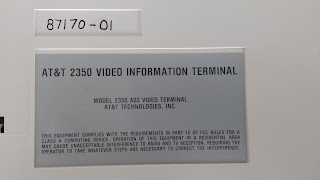"CAPTAIN terminals and NAPLPS terminals using the V9938 have already been developed. We hope that the V9938 will be a standard video processing device on a worldwide basis."The "V9938 MSX-VIDEO Technical Data Book" is from August of 1985 and the V9938's copyright is from 1984. That give a narrow time window for these supposed terminals be released. But the text says "developed" not "released" which opens the possibility that these terminals were released in later dates. Which doesn't helps a lot in my search.
But then I found something in Kazuhiko Nishi's resumé, talking about the V9938:
 |
| Kazuhiko Nishi's resumé entry about V9938 |
The Japanese text:
ビデオスプライトプロセッサー開発When translated by Google to English:
MSX2に使用するためにスプライトとグラフィックスが表示可能なプロセッサーをYAMAHAと共同で開発した。このLSI V9938は、500万本以上生産され米AT&T社情報端末にも採用された。
Video sprite processor developmentGives a very good clue to follow. AT&T was one of the creators of NAPLPS protocol and also sold NAPLPS terminals, maybe now we can find the mythical terminals with V9938 inside. So, let's leave the Japan terminals for a while and go to check the devices from USA.
In collaboration with YAMAHA, we developed a processor capable of displaying sprites and graphics for use on MSX 2. This LSI V9938 was produced in more than 5 million units and was also adopted for AT & T Inc. information terminals.
AT&T and NAPLPS
The first Videotex systems came from Europe, in the seventies, the best graphics they can do is to use some semi-graphical characters to assemble pictures in the screen. The semi-graphical characters are OK for that time, as we can see in ZX-81 and TRS-80 Model I (and remember that the Viewdata is older than both, first prototype is from 1974).
A research group from Communications Research Centre in Canada followed other path. Given their background building CAD programs and plotting devices, they doesn't wanted to tie the graphical capabilities of their videotex system to any resolution available at that time. They created a language to describe the graphics as dots, lines, circles, arcs and polygons. This videotex system is called Telidon and the first public terminal is from 1978.
Why all this story? Well, the Telidon was the basis for the NAPLPS. We already saw that the videotex was the technological buzzword of the late seventies/early eighties, but the AT&T had not a system to offer. To mind this gap they choose to join the Telidon project and added some new commands and features.
That extended videotex system is the NAPLPS, acronym for North American Presentation Level Protocol Syntax, announced by CRC, Bell Canada and AT&T in 1983. With the tecnology itself consolided, AT&T then joined Knight-Ridder Newspapers and released the Viewtron, initially at Southern Florida.
 |
| Some NAPLPS screens from an InfoWorld's article about Viewtron launch (InfoWorld - 1984/04/09) |
In this joint-venture, the Knight-Ridder was responsible to provide the contents (news, articles, etc) and AT&T to provide the infra-structure; including the NAPLPS decoders. The decoder provided was the AT&T Sceptre:
 |
| The Sceptre Terminal and its wireless keyboard |
You can see the services provided by Viewtron and the AT&T Sceptre at wild in this video:
Although the Viewtron services looks very complete (online shopping in 1980's!!!) and the Sceptre was an impressive machine, in 1986 the Viewtron was finished. Not enough consumers that were willing to pay for the terminal and the service fees. Being fair with Viewtron, the same happened with most Videotex services.
Back to this blog subject, MSX archeology, the AT&T Sceptre can't be the NAPLPS terminal with V9938. The time window doesn't match, it was released in 1983. And in Wikipedia's Sceptre entry it says the video controller is the MC6845.
Luckly to us, the Sceptre wasn't the only one NAPLPS terminal released by AT&T. In my search I found at least other three for personal use: AT&T 1300, AT&T 2300 and AT&T 2350. And, as you can deduce from this post's title, I bought one AT&T 2300/2350 Video Information Terminal. As you can see in the picture below, It looks promising...
 |
| Finally, I found a NAPLPS terminal that uses the Yamaha V9938!! |
The AT&T 2300/2350 was released in 1987, so it can be one of those NAPLPS terminals "developed" before Aug-1985, we know that sometimes the time between project and release can be very long. But I don't believe it's the case.
 |
| Handwritten serial number |
Probably older models of NAPLPS terminals at AT&T were the ones cited in the "V9938 MSX-VIDEO Technical Data Book", so more search is needed. But, at least, this is a proof that V9938 was used by some dedicated NAPLPS terminals.
Next post we'll talk a bit more about this equipment.

No comments:
Post a Comment